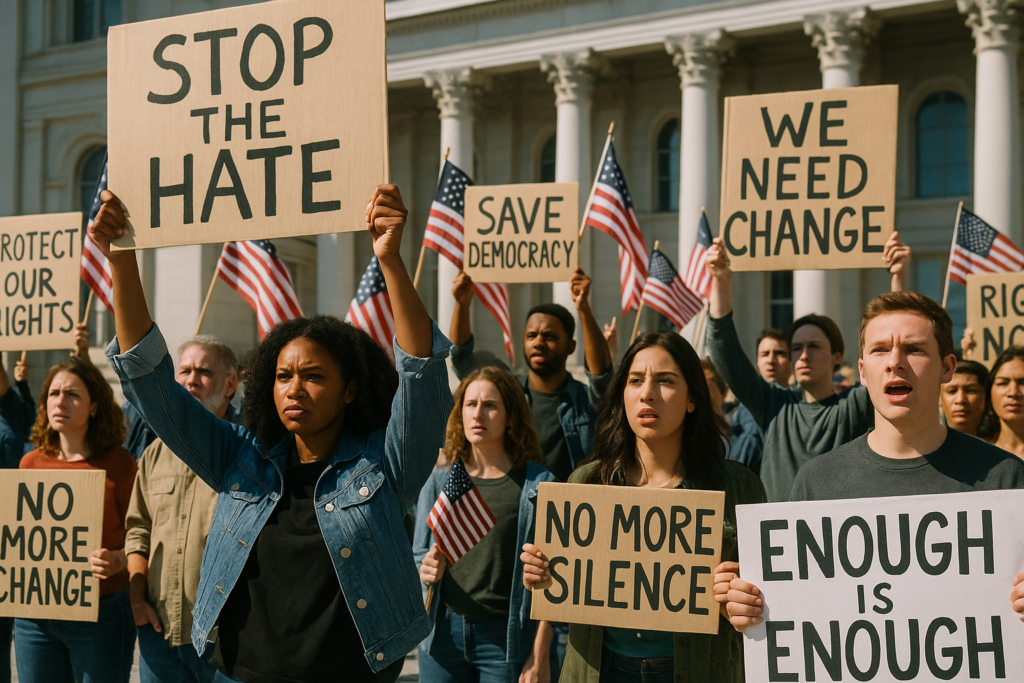Widespread Protest Sweeps U.S. in Response to Trump Administration Actions
On April 19, 2025, Americans in cities large and small came together in a sweeping display of civic engagement and resistance, staging protests against what they described as the most troubling policies of President Donald Trump’s (Republican) administration. Long-tail keywords such as “nationwide U.S. protests against Trump policies,” “anti-Trump rallies 2025,” and “community organizing against mass deportations” are resonating as concerned citizens seek to make sense of an unprecedented moment in American democracy.
Across Washington, D.C., New York, Denver, San Francisco, Portland, and Anchorage, demonstrators voiced urgent concerns about a series of Trump administration actions—particularly mass deportations, the firing of over 200,000 federal workers, and escalating military involvement in foreign wars—that many view as a threat to the nation’s core values. According to reports, the movement was not confined to political strongholds: rural towns and university campuses were also scenes of passionate dissent.
Activists, students, and families joined the nationwide groundswell, drawing strength from solidarity and shared purpose. Many cited threats to democratic norms, the integrity of U.S. institutions, and the well-being of marginalized communities as motivating factors. The sheer scale of the response was apparent: the grassroots 50501 movement helped organize over 400 events, including traditional protests, community service activities, and teach-ins across the country.
“This is about our communities, our neighbors, and our future. We cannot stand by while so many of our rights and livelihoods are under attack,” said Maria Sanchez, an organizer at a New York City rally.
The day’s collective action followed closely on the heels of earlier demonstrations this month—most notably the “Hands Off!” rallies, which united people from all 50 states to defend the social safety net and public sector jobs from targeted government cuts.
Main Narrative: Protesters Rally Against Deportations, Job Losses, and Erosion of Rights
Thousands flooded city centers, federal buildings, and college campuses, brandishing signs that read “Protect Our Democracy,” “No to Mass Deportations,” and “Education Is a Right.” The message was loud and clear: these policies, particularly the mass deportations and federal worker firings, have ignited urgent fears about the nation’s humanitarian, economic, and constitutional health.
On April 19, Americans from diverse backgrounds joined in opposition, with the 50501 movement orchestrating more than 400 events—ranging from street protests to community-driven actions like nature cleanups and food drives—demonstrating that activism is as much about building as it is about resisting (read more from Axios). As crowds assembled in Washington, D.C., attention focused on federal policy changes that have upended countless lives. City after city echoed the same refrain: a call for the protection of democratic institutions, fair treatment of immigrants, and preservation of critical public services.
Campus activism was especially prominent. University students, already reeling from steep funding cuts and restrictions on free speech, staged walkouts and teach-ins to highlight the impact of federal actions on their educational futures. “We’re seeing the direct consequences of policy on students’ abilities to learn, speak out, and even remain in the country if they’re international,” commented Professor Raheem Patel, a faculty advisor for a university protest.
“What’s happening extends beyond politics; it’s about our fundamental rights and the dignity of every person in America,” said Leroy Thompson, a federal employee facing potential job loss.
Protest organizers and participants are determined not to let the gravity of the situation breed despair—instead, they are channeling frustration into organized, hopeful action. These demonstrations have been a reminder that mass mobilization can amplify the voices of those who might otherwise be left out of the national conversation.
Contextual Background: Policy Precedents, Civil Society’s Response, and the Road Ahead
For many, the current wave of activism borrows lessons from earlier chapters of American advocacy for social justice—era-defining protests for civil rights, immigrant protections, and more recent movements like the 2020 demonstrations for racial justice. The Trump administration’s sweeping policy changes in 2025—especially mass firings and deep cuts to health, education, and social supports—have sparked new urgency (as documented by the Associated Press).
The 50501 movement, named for the date of its initial nationwide day of action, stressed the interconnectedness of American struggles: organizing traditional protests alongside mutual aid efforts like food banks and neighborhood cleanups. These strategies reflect a recognition that protecting democracy is not only a matter of opposing harmful policies, but also of supporting the most vulnerable.
“We learned from earlier generations of activists that broad coalitions—and caring for one another—make movements last. Every contribution, no matter how small, helps build the future we want,” said Dr. Lisa Cho, a historian of U.S. protest movements.
Universities have long been crucibles of dissent, and they are once again at the forefront. Recent restrictions on academic funding and international student programs threatening to erode the very diversity and dynamism that American higher education is known for (according to reporting from the Associated Press). Meanwhile, the firings of federal workers have put entire communities at risk, as public sector jobs are often lifelines in both urban and rural areas.
In the face of these sweeping changes, the resolve shown on April 19 is a testament to the enduring spirit of community-led resistance. Organizers argue that the country is at a turning point, and the outcome will depend on the ongoing commitment to civic participation, solidarity, and hope. The road ahead will require persistence and creativity, but history has shown that democratic engagement—when broad, brave, and persistent—has the power to shape policy and protect fundamental rights.


